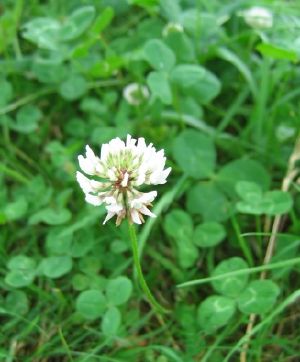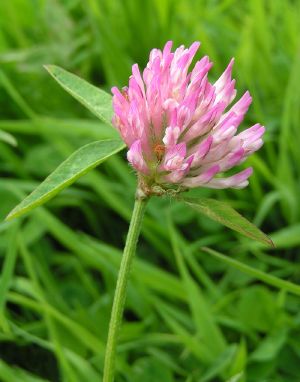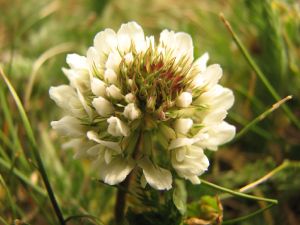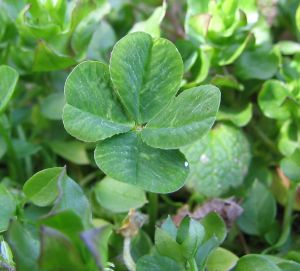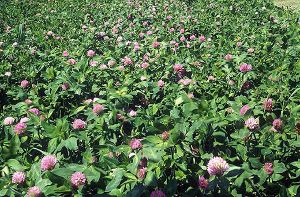Difference between revisions of "Clover" - New World Encyclopedia
Rick Swarts (talk | contribs) |
Rick Swarts (talk | contribs) (added images ok tag) |
||
| Line 1: | Line 1: | ||
| − | {{Claimed}} | + | {{Claimed}}{{Images OK}} |
{{Taxobox | {{Taxobox | ||
| name = Clover | | name = Clover | ||
| Line 22: | Line 22: | ||
There are other plants that also utilize the common name clover that are not part of this genus. [[Sweet clover]] is the name used to refer to all but one species ([[sour clover]], ''Melilotus indica'') in the genus ''Melilotus'' of the family Fabaceae. Bush clover or Japanese clover is the common name applied to plants of the Fabaceae family ''Lespedeza''. Even some non-leguminous plants have the name clover, such as [[water clover]] (genus ''Marsilea'' of family [[Marsileaceae]]) and owl's clover (genus ''Triphysaria'' of the family [[Scrophulariaceae]]). | There are other plants that also utilize the common name clover that are not part of this genus. [[Sweet clover]] is the name used to refer to all but one species ([[sour clover]], ''Melilotus indica'') in the genus ''Melilotus'' of the family Fabaceae. Bush clover or Japanese clover is the common name applied to plants of the Fabaceae family ''Lespedeza''. Even some non-leguminous plants have the name clover, such as [[water clover]] (genus ''Marsilea'' of family [[Marsileaceae]]) and owl's clover (genus ''Triphysaria'' of the family [[Scrophulariaceae]]). | ||
| − | Clover is a very important species, used for [[pasture]], [[hay]], [[silage]], replenishing [[nitrogen]] and other nutrients in the [[soil]], control of erosion, and as a [[honeybee]] [[nectar]] source. The ''McGraw-Hill Concise Encyclopedia of Science & Technology'' (2005) states that "collectively they represent the most important genus of forage legumes in agriculture." | + | Clover is a very important species, used for [[pasture]], [[hay]], [[silage]], replenishing [[nitrogen]] and other nutrients in the [[soil]], control of erosion, and as a [[honeybee]] [[nectar]] source. The ''McGraw-Hill Concise Encyclopedia of Science & Technology'' (2005) states that "collectively they represent the most important genus of forage legumes in [[agriculture]]." |
==Description== | ==Description== | ||
| Line 28: | Line 28: | ||
Clover is a member of the [[flowering plant]] family, Fabaceae (also called ''Leguminosae''). They are one of the largest plant families and include [[bean]]s, [[pea]]s, [[peanut]]s, lupines, alfalfa, acacia, and many others. Fabaceae is known variously as the legume family, pea family, bean family, or pulse family. | Clover is a member of the [[flowering plant]] family, Fabaceae (also called ''Leguminosae''). They are one of the largest plant families and include [[bean]]s, [[pea]]s, [[peanut]]s, lupines, alfalfa, acacia, and many others. Fabaceae is known variously as the legume family, pea family, bean family, or pulse family. | ||
| + | [[Image:Trifolium-repens.jpg|thumb|left|White Clover flower-head and leaves]] | ||
All members of this family have five-petaled [[flower]]s in which the superior ovary (an ovary attached to the receptacle above the attachment of other floral parts) ripens to form a "pod," technically called a legume, whose two sides split apart, releasing the seeds that are attached to one or both seams. | All members of this family have five-petaled [[flower]]s in which the superior ovary (an ovary attached to the receptacle above the attachment of other floral parts) ripens to form a "pod," technically called a legume, whose two sides split apart, releasing the seeds that are attached to one or both seams. | ||
| Line 36: | Line 37: | ||
The clovers, members of the genus ''Trifolium'', are small [[annual plant|annual]], [[biennial plant|biennial]], or short-lived [[perennial plant|perennial]] [[herbaceous]] plants. The alternate, compound leaves usually are trifoliate (rarely 5- or 7-foliate), with stipules adnate to the leaf-stalk, and heads or crowded spikes of small, fragrant, red, purple, white, or yellow flowers; the small, few-seeded pods are enclosed in the [[flower|calyx]]. | The clovers, members of the genus ''Trifolium'', are small [[annual plant|annual]], [[biennial plant|biennial]], or short-lived [[perennial plant|perennial]] [[herbaceous]] plants. The alternate, compound leaves usually are trifoliate (rarely 5- or 7-foliate), with stipules adnate to the leaf-stalk, and heads or crowded spikes of small, fragrant, red, purple, white, or yellow flowers; the small, few-seeded pods are enclosed in the [[flower|calyx]]. | ||
| − | The scientific name derives from the [[Latin]] ''tres'', "three" | + | The scientific name derives from the [[Latin]] ''tres'', "three," and ''folium'', "leaf," so called from the characteristic form of the leaf, which has three [[leaflet]]s (trifoliate); hence the popular name [[trefoil]]. |
== Cultivation and importance== | == Cultivation and importance== | ||
| − | |||
| − | |||
| − | + | [[Image:Red clover close 800.jpg|thumb|Red clover flowers]] | |
| + | Several species are extensively cultivated as fodder-plants. The most widely cultivated clovers are [[white clover]] ''Trifolium repens'' and [[red clover]] ''Trifolium pratense''. | ||
| − | Clover | + | Clover, either sown alone or in mixture with [[ryegrass]], has for a long time formed a staple crop for soiling, for several reasons: it grows freely, shooting up again after repeated mowings; it produces an abundant crop; it is palatable to and nutritious for [[livestock]]; it grows in a great range of [[soil]]s and [[climate]]s; and it is appropriate for either pasturage or green composting. |
| − | + | In many areas, particularly on acidic soil, clover is short-lived because of a combination of insect pests, diseases, and nutrient balance; this is known as "clover sickness." When [[crop rotation]]s are managed so that clover does not recur at shorter intervals than eight years, it grows with much of its pristine vigor. | |
| − | |||
| − | [[ | + | Clover sickness in more recent times may also be linked to [[pollinator decline]]; clovers are most efficiently pollinated by [[bumblebee]]s, which have declined as a result of agricultural intensification. [[Honeybee]]s can also pollinate clover, and [[beekeeper]]s are often in heavy demand from farmers with clover pastures. Farmers enjoy the benefits of increased reseeding that occurs with increased bee activity, which means that future clover yields remain abundant. Beekeepers benefit from the clover bloom as clover is one of the main nectar sources for honeybees. |
| − | |||
| − | + | [[Image:Trifolium repens2.jpg|left|thumb|White clover flower]] | |
| + | ''T. repens'', white or Dutch clover, is a perennial that is abundant in meadows and good pastures. The flowers are white or pinkish, becoming brown and deflexed as the corolla fades. ''T. hybridum'', alsike or Swedish clover, is a perennial that was introduced early in the 19th century and has now become naturalized in Britain. The flowers are white or rosy, and resemble those of the last species. ''T. medium'', meadow or zigzag clover, a perennial with straggling flexuous stems and rose-purple flowers, is of little agricultural value. | ||
| − | + | Other British species include: | |
| − | + | *''T. arvense'', hare's-foot trefoil; found in fields and dry pastures, a soft hairy plant with minute white or pale pink flowers and feathery sepals; | |
| + | *''T. fragiferum'', strawberry clover, with densely-flowered, globose, rose-purple heads and swollen calyxes; | ||
| + | *''T. procumbens'', hop trefoil, on dry pastures and roadsides, the heads of pale yellow flowers suggesting miniature hops; and | ||
| + | * ''T. minus'', common in pastures and roadsides, with smaller heads and small yellow flowers turning dark brown. The last named is often called [[shamrock]]. | ||
| − | + | All of the cultivated forms in America of agricultural importance are introduced plants, rather than native. These include ''T. pratense'' (red clover), ''T. repens'' (white clover), ''T. hybridum'' (alsike clover), ''T. fragiferum'' (strawberry clover), and ''T. procumbens'' (hop clover). | |
| − | + | Clovers are a valuable survival food for people, as they are high in [[protein]], widespread, and abundant. They are not easy to digest raw, but this can be easily fixed by juicing them or boiling them for 5-10 minutes. Dried flower heads and seedpods can also be ground up into a nutritious [[flour]] and mixed with other foods. Dried flower heads can also be steeped in hot water for a healthy, tasty tea | |
| − | + | ===Symbolism and mythology=== | |
| + | [[Image:Four-leaf clover.jpg|thumb|A four-leaf clover ]][[Shamrock]], the traditional [[Ireland|Irish]] symbol coined by [[Saint Patrick]] for the [[Holy Trinity]], is commonly associated with clover, though also sometimes with ''[[Oxalis]]'' species, which are also trifoliate (i.e. they have three leaves). | ||
| + | |||
| + | Clovers occasionally have leaves with four leaflets, instead of the usual three. These [[four-leaf clover]]s, like other rarities, are considered lucky. A common [[idiom]] is "to be in clover," meaning to be living a carefree life of ease, comfort, or prosperity. | ||
== Selected Species == | == Selected Species == | ||
| − | [[Image:Red clover field.jpg|right|thumb|Red clover | + | [[Image:Red clover field.jpg|right|thumb|Red clover ''(Trifolium pratense)'']] |
[[Image:Irelandclover.jpg|thumb|right|250px|A closeup of clover in [[Ireland]]]] | [[Image:Irelandclover.jpg|thumb|right|250px|A closeup of clover in [[Ireland]]]] | ||
| Line 178: | Line 183: | ||
==References== | ==References== | ||
| − | |||
| − | |||
* {{1911}} | * {{1911}} | ||
| − | * [http://www. | + | * McGraw-Hill. 2005. ''McGraw-Hill Concise Encyclopedia of Science & Technology'', 5th edition. 2005. New York: McGraw-Hill. ISBN 0071429573. |
| + | |||
| + | * Milius, S. 2007. Most bees live alone: No hives, no honey, but maybe help for crops. ''Science News'' 171(1): 11-13. | ||
| + | |||
| + | * University of Minnestota (UM). 2003. [http://www.extension.umn.edu/distribution/cropsystems/components/DC5963a.html ''Forage Legumes'', 2nd ed.]] ''University of Minnestora'' SM-05963. Retrieved April 11, 2008. | ||
| − | |||
| − | |||
[[Category:Life sciences]] | [[Category:Life sciences]] | ||
Revision as of 20:56, 11 April 2008
| Clover | ||||||||||||||||
|---|---|---|---|---|---|---|---|---|---|---|---|---|---|---|---|---|
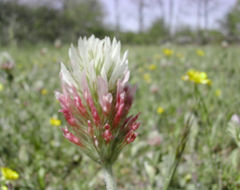 clover inflorescence
| ||||||||||||||||
| Scientific classification | ||||||||||||||||
| ||||||||||||||||
|
See text |
Clover, or trefoil, is the common name for any of the various herbaceous, leguminous plants comprising the genus Trifolium in the pea family Fabaceae, typically characterized by trifoliolate leaves (having three leaflets) and heads or dense spikes of small red, purple, white, or yellow flowers. There are about 300 species in this genus. The genus has a cosmopolitan distribution; the highest diversity is found in the temperate Northern Hemisphere, but many species also occur in South America and Africa, including at high altitudes on mountains in the tropics.
There are other plants that also utilize the common name clover that are not part of this genus. Sweet clover is the name used to refer to all but one species (sour clover, Melilotus indica) in the genus Melilotus of the family Fabaceae. Bush clover or Japanese clover is the common name applied to plants of the Fabaceae family Lespedeza. Even some non-leguminous plants have the name clover, such as water clover (genus Marsilea of family Marsileaceae) and owl's clover (genus Triphysaria of the family Scrophulariaceae).
Clover is a very important species, used for pasture, hay, silage, replenishing nitrogen and other nutrients in the soil, control of erosion, and as a honeybee nectar source. The McGraw-Hill Concise Encyclopedia of Science & Technology (2005) states that "collectively they represent the most important genus of forage legumes in agriculture."
Description
Clover is a member of the flowering plant family, Fabaceae (also called Leguminosae). They are one of the largest plant families and include beans, peas, peanuts, lupines, alfalfa, acacia, and many others. Fabaceae is known variously as the legume family, pea family, bean family, or pulse family.
All members of this family have five-petaled flowers in which the superior ovary (an ovary attached to the receptacle above the attachment of other floral parts) ripens to form a "pod," technically called a legume, whose two sides split apart, releasing the seeds that are attached to one or both seams.
The legumes are traditionally classified into three subfamilies (in some taxonomies these are raised to the rank of family in the order Fabales), of which clover belongs to the subfamily Faboideae or Papilionoideae. Plants in this subfamily have one petal that is large and has a crease in it, while the two adjacent petals are on the sides, and the two bottom petals are joined together at the bottom, forming a boat-like structure. Most of the legumes, including those well-known as food crops, are in this sub-family.
Most legumes, through a symbiotic relationship with certain bacteria called rhizobia are able to take nitrogen from the air and "fix" it, that is change it into chemical compounds that can be used by plants. This is the process of nitrogen fixation. The nitrogen is then available to be used by animals that eat the legume plants and by other plants when it is absorbed by the soil after the legumes' death.
The clovers, members of the genus Trifolium, are small annual, biennial, or short-lived perennial herbaceous plants. The alternate, compound leaves usually are trifoliate (rarely 5- or 7-foliate), with stipules adnate to the leaf-stalk, and heads or crowded spikes of small, fragrant, red, purple, white, or yellow flowers; the small, few-seeded pods are enclosed in the calyx.
The scientific name derives from the Latin tres, "three," and folium, "leaf," so called from the characteristic form of the leaf, which has three leaflets (trifoliate); hence the popular name trefoil.
Cultivation and importance
Several species are extensively cultivated as fodder-plants. The most widely cultivated clovers are white clover Trifolium repens and red clover Trifolium pratense.
Clover, either sown alone or in mixture with ryegrass, has for a long time formed a staple crop for soiling, for several reasons: it grows freely, shooting up again after repeated mowings; it produces an abundant crop; it is palatable to and nutritious for livestock; it grows in a great range of soils and climates; and it is appropriate for either pasturage or green composting.
In many areas, particularly on acidic soil, clover is short-lived because of a combination of insect pests, diseases, and nutrient balance; this is known as "clover sickness." When crop rotations are managed so that clover does not recur at shorter intervals than eight years, it grows with much of its pristine vigor.
Clover sickness in more recent times may also be linked to pollinator decline; clovers are most efficiently pollinated by bumblebees, which have declined as a result of agricultural intensification. Honeybees can also pollinate clover, and beekeepers are often in heavy demand from farmers with clover pastures. Farmers enjoy the benefits of increased reseeding that occurs with increased bee activity, which means that future clover yields remain abundant. Beekeepers benefit from the clover bloom as clover is one of the main nectar sources for honeybees.
T. repens, white or Dutch clover, is a perennial that is abundant in meadows and good pastures. The flowers are white or pinkish, becoming brown and deflexed as the corolla fades. T. hybridum, alsike or Swedish clover, is a perennial that was introduced early in the 19th century and has now become naturalized in Britain. The flowers are white or rosy, and resemble those of the last species. T. medium, meadow or zigzag clover, a perennial with straggling flexuous stems and rose-purple flowers, is of little agricultural value.
Other British species include:
- T. arvense, hare's-foot trefoil; found in fields and dry pastures, a soft hairy plant with minute white or pale pink flowers and feathery sepals;
- T. fragiferum, strawberry clover, with densely-flowered, globose, rose-purple heads and swollen calyxes;
- T. procumbens, hop trefoil, on dry pastures and roadsides, the heads of pale yellow flowers suggesting miniature hops; and
- T. minus, common in pastures and roadsides, with smaller heads and small yellow flowers turning dark brown. The last named is often called shamrock.
All of the cultivated forms in America of agricultural importance are introduced plants, rather than native. These include T. pratense (red clover), T. repens (white clover), T. hybridum (alsike clover), T. fragiferum (strawberry clover), and T. procumbens (hop clover).
Clovers are a valuable survival food for people, as they are high in protein, widespread, and abundant. They are not easy to digest raw, but this can be easily fixed by juicing them or boiling them for 5-10 minutes. Dried flower heads and seedpods can also be ground up into a nutritious flour and mixed with other foods. Dried flower heads can also be steeped in hot water for a healthy, tasty tea
Symbolism and mythology
Shamrock, the traditional Irish symbol coined by Saint Patrick for the Holy Trinity, is commonly associated with clover, though also sometimes with Oxalis species, which are also trifoliate (i.e. they have three leaves).
Clovers occasionally have leaves with four leaflets, instead of the usual three. These four-leaf clovers, like other rarities, are considered lucky. A common idiom is "to be in clover," meaning to be living a carefree life of ease, comfort, or prosperity.
Selected Species
|
|
|
ReferencesISBN links support NWE through referral fees
- This article incorporates text from the Encyclopædia Britannica Eleventh Edition, a publication now in the public domain.
- McGraw-Hill. 2005. McGraw-Hill Concise Encyclopedia of Science & Technology, 5th edition. 2005. New York: McGraw-Hill. ISBN 0071429573.
- Milius, S. 2007. Most bees live alone: No hives, no honey, but maybe help for crops. Science News 171(1): 11-13.
- University of Minnestota (UM). 2003. Forage Legumes, 2nd ed.] University of Minnestora SM-05963. Retrieved April 11, 2008.
Credits
New World Encyclopedia writers and editors rewrote and completed the Wikipedia article in accordance with New World Encyclopedia standards. This article abides by terms of the Creative Commons CC-by-sa 3.0 License (CC-by-sa), which may be used and disseminated with proper attribution. Credit is due under the terms of this license that can reference both the New World Encyclopedia contributors and the selfless volunteer contributors of the Wikimedia Foundation. To cite this article click here for a list of acceptable citing formats.The history of earlier contributions by wikipedians is accessible to researchers here:
The history of this article since it was imported to New World Encyclopedia:
Note: Some restrictions may apply to use of individual images which are separately licensed.
